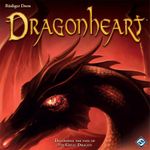- Publisher
- Fantasy Flight Games
- Published in
- 2010
- My Rating
- 8.5
- BGG Rating
- 6.13
- BGG Rank
- 2335
- Players
- 2
- Ages
- 13+
- Duration
- 0:30
- Complexity
- 1.3553 / 5
- Acquired
- December 2010
- Eager to Play
- No
- Plays
- 5
- Last Played
- August 09, 2011
- Time Spent
- 1:30
Dragonheart is a two-player card game of indirection. Each player starts out with an identical deck of cards, distinguished by color; each player shuffles his or her deck then draws a hand of 5 cards. Between the two players is a board with 10 different areas, each area set aside for a different type of card, and each area indicating how many cards can be played until it is full and its action triggered resulting in a different area of cards added to the player's score pile. Each turn players take turn playing as many cards of a single type as they desire (providing there is room on the board), they then score cards if they trigger an action, then finally draw cards from their private deck until their hand is full. At the end of the game the player with the highest score wins.
During the game each player must decide where to play his or her cards on the board. Some areas require more than one card before scoring, others a single card, and one area will never trigger, but allows a player to stack up a large amount of points to later capture. The game is symmetric, which adds to the tension, because each player knows the other player has the same opportunities; a card played in preparation for later scoring might be scored by your opponent on the following turn. The game plays fast (15-20 minutes) and has elements of playing your opponent as well as playing the game, as you are constantly guessing what your opponent will play next. It's a game of give and take with hidden depth.
Five plays
- August 09, 2011
- January 01, 2011 x3
- December 30, 2010
